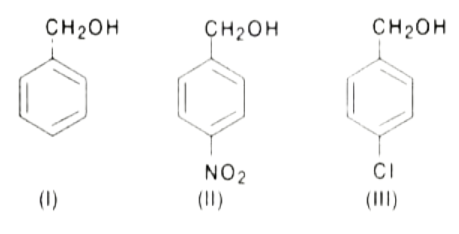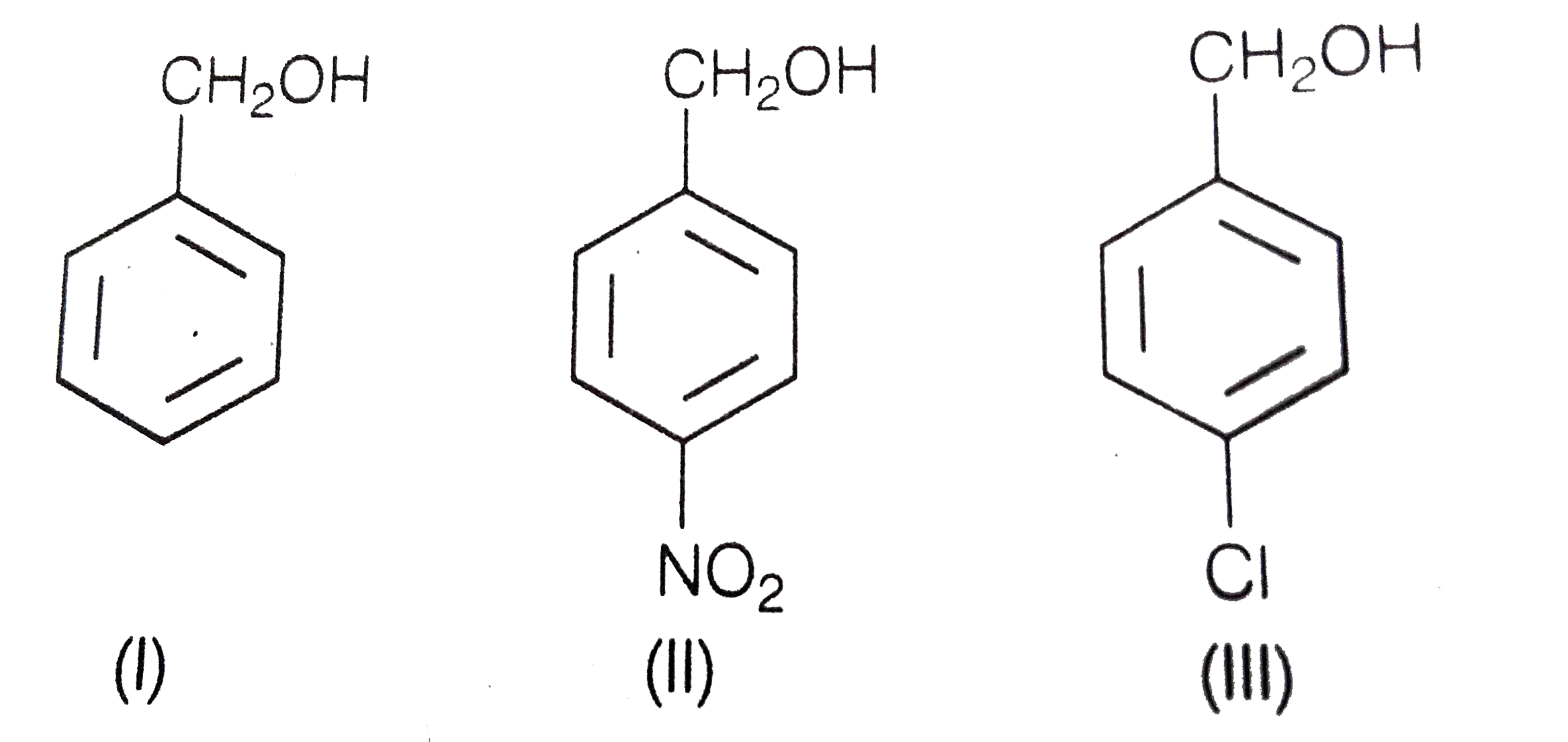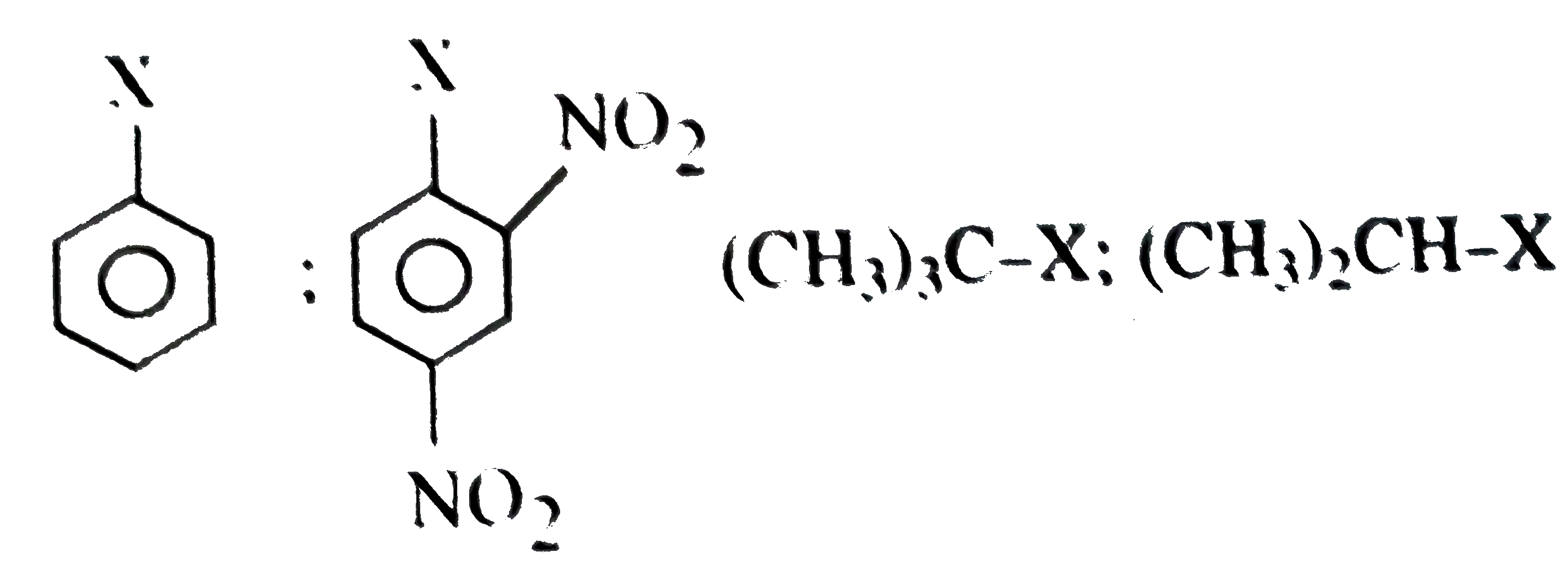Mark the correct order of increasing reactivity.
CH3CONH2<CH2COOC2H5<CH3COCl
CH3COOC2H5<CH3COCl<CH3CONH2
CH3COCl<CH3CONH2<CH3COOC2H5
CH3COOC2H5<CH3CONH2<CH3COCl.
The correct Answer is:A
To determine the correct order of increasing reactivity for the given acid derivatives (amide, ester, and acid chloride), we need to analyze the reactivity based on the stability of their leaving groups. Here’s the step-by-step solution:
Step 1: Identify the Compounds
We have three acid derivatives:
1. Amide (RCONH2)
2. Ester (RCOOR')
3. Acid Chloride (RCOCl)
Step 2: Understand the Leaving Groups
The reactivity of these compounds largely depends on the ability of their leaving groups to depart during a reaction. The more stable the leaving group, the more reactive the compound.
- Amide: The leaving group is NH2^− (amide ion), which is not very stable and does not leave easily.
- Ester: The leaving group is RO^− (alkoxide ion), which can leave but is more stable than NH2^−.
- Acid Chloride: The leaving group is Cl^− (chloride ion), which is very stable and can leave easily.
Step 3: Rank the Leaving Groups
Based on the stability of the leaving groups, we can rank them:
1. Cl^− (from acid chloride) - most stable and leaves easily.
2. RO^− (from ester) - moderately stable and can leave.
3. NH2^− (from amide) - least stable and does not leave easily.
Step 4: Determine Reactivity Order
Since the reactivity increases with the ease of leaving the group, we can conclude:
- Acid Chloride (most reactive)
- Ester (moderately reactive)
- Amide (least reactive)
Step 5: Write the Increasing Order of Reactivity
Thus, the correct order of increasing reactivity is:
Amide < Ester < Acid Chloride
Final Answer
The correct order of increasing reactivity is:
Amide < Ester < Acid Chloride
We have three acid derivatives:
1. Amide (RCONH2)
2. Ester (RCOOR')
3. Acid Chloride (RCOCl)
The reactivity of these compounds largely depends on the ability of their leaving groups to depart during a reaction. The more stable the leaving group, the more reactive the compound.
- Ester: The leaving group is RO^− (alkoxide ion), which can leave but is more stable than NH2^−.
- Acid Chloride: The leaving group is Cl^− (chloride ion), which is very stable and can leave easily.
Based on the stability of the leaving groups, we can rank them:
1. Cl^− (from acid chloride) - most stable and leaves easily.
2. RO^− (from ester) - moderately stable and can leave.
3. NH2^− (from amide) - least stable and does not leave easily.
Since the reactivity increases with the ease of leaving the group, we can conclude:
- Acid Chloride (most reactive)
- Ester (moderately reactive)
- Amide (least reactive)
Thus, the correct order of increasing reactivity is:
Amide < Ester < Acid Chloride
The correct order of increasing reactivity is:
Amide < Ester < Acid Chloride
Topper's Solved these Questions
- CARBOXYLIC ACIDS AND THEIR DERIVATIVESBOOK - CENGAGE CHEMISTRY ENGLISHCHAPTER - CARBOXYLIC ACIDS AND THEIR DERIVATIVESEXERCISE - Exercises (Assertion-Reasoning)
10 Videos
- CARBOXYLIC ACIDS AND THEIR DERIVATIVESBOOK - CENGAGE CHEMISTRY ENGLISHCHAPTER - CARBOXYLIC ACIDS AND THEIR DERIVATIVESEXERCISE - Exercises Archives (Single Correct)
10 Videos
- CARBOXYLIC ACIDS AND THEIR DERIVATIVESBOOK - CENGAGE CHEMISTRY ENGLISHCHAPTER - CARBOXYLIC ACIDS AND THEIR DERIVATIVESEXERCISE - Exercises (Multiple Correct)
34 Videos
- BIOMOLECULESBOOK - CENGAGE CHEMISTRY ENGLISHCHAPTER - BIOMOLECULESEXERCISE - Exercises Archives (Analytical And Descriptive)
8 Videos
- CHEMICAL KINETICSBOOK - CENGAGE CHEMISTRY ENGLISHCHAPTER - CHEMICAL KINETICSEXERCISE - Archives Subjective
23 Videos
Similar Questions
Knowledge Check
Give the correct order of increasing acidity of the following compounds.
 AII<I<IV<IIIBIV<II<I<IIICI<II<IV<IIIDIV<I<II<III
AII<I<IV<IIIBIV<II<I<IIICI<II<IV<IIIDIV<I<II<III
The correct order of increasing electronegativity of the following elements is:
View SolutionThe correct order of increasing electronegativity of the following elements is:
View SolutionMark the correct order of decreasing acid strength of the following compounds

View SolutionMark the correct order of decreasing acid strength of the following compounds.

View SolutionMark the correct increasing order of reactivity of the following compounds with HBr/HCI.

View SolutionMark the correct increasing order of reactivity of the following compounds with HBr/HCl.

View SolutionMark the correct increasing order of reactivity of the following compounds with HBr/HCl.

View Solution

